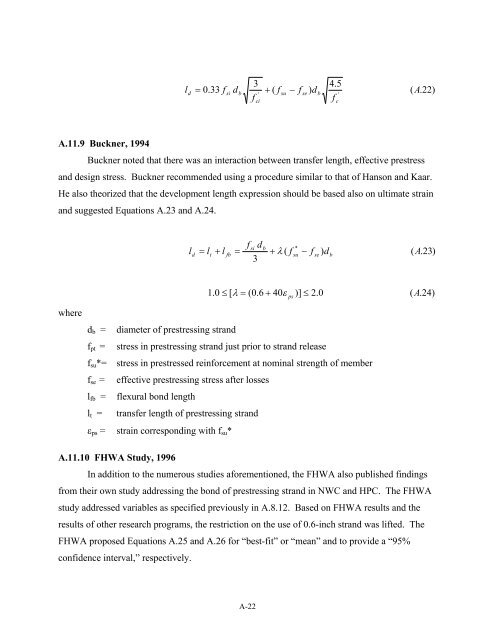Lightweight Concrete for High Strength - Expanded Shale & Clay
Lightweight Concrete for High Strength - Expanded Shale & Clay
Lightweight Concrete for High Strength - Expanded Shale & Clay
You also want an ePaper? Increase the reach of your titles
YUMPU automatically turns print PDFs into web optimized ePapers that Google loves.
l<br />
d<br />
3<br />
4.5<br />
= 0 .33 f<br />
si<br />
d<br />
b<br />
+ ( f f ) d<br />
' su<br />
−<br />
se b '<br />
f<br />
f<br />
ci<br />
c<br />
( A.22)<br />
A.11.9 Buckner, 1994<br />
Buckner noted that there was an interaction between transfer length, effective prestress<br />
and design stress. Buckner recommended using a procedure similar to that of Hanson and Kaar.<br />
He also theorized that the development length expression should be based also on ultimate strain<br />
and suggested Equations A.23 and A.24.<br />
l<br />
d<br />
f<br />
si<br />
d<br />
b<br />
= lt<br />
+ l<br />
fb<br />
= + λ ( f<br />
3<br />
*<br />
su<br />
−<br />
f<br />
se<br />
) d<br />
b<br />
( A.23)<br />
1.0<br />
≤ [ λ = (0.6 + 40ε<br />
)] ≤ 2.0<br />
( A.24)<br />
ps<br />
where<br />
d b = diameter of prestressing strand<br />
f pt = stress in prestressing strand just prior to strand release<br />
f su *= stress in prestressed rein<strong>for</strong>cement at nominal strength of member<br />
f se = effective prestressing stress after losses<br />
l fb = flexural bond length<br />
l t = transfer length of prestressing strand<br />
ε ps = strain corresponding with f su *<br />
A.11.10 FHWA Study, 1996<br />
In addition to the numerous studies a<strong>for</strong>ementioned, the FHWA also published findings<br />
from their own study addressing the bond of prestressing strand in NWC and HPC. The FHWA<br />
study addressed variables as specified previously in A.8.12. Based on FHWA results and the<br />
results of other research programs, the restriction on the use of 0.6-inch strand was lifted. The<br />
FHWA proposed Equations A.25 and A.26 <strong>for</strong> “best-fit” or “mean” and to provide a “95%<br />
confidence interval,” respectively.<br />
A-22















